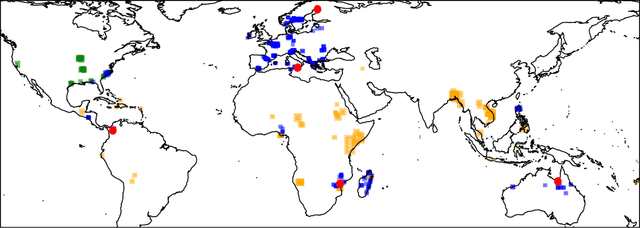Guy Schumann
Pix2Streams: Dynamic Hydrology Maps from Satellite-LiDAR Fusion
Nov 15, 2020



Abstract:Where are the Earth's streams flowing right now? Inland surface waters expand with floods and contract with droughts, so there is no one map of our streams. Current satellite approaches are limited to monthly observations that map only the widest streams. These are fed by smaller tributaries that make up much of the dendritic surface network but whose flow is unobserved. A complete map of our daily waters can give us an early warning for where droughts are born: the receding tips of the flowing network. Mapping them over years can give us a map of impermanence of our waters, showing where to expect water, and where not to. To that end, we feed the latest high-res sensor data to multiple deep learning models in order to map these flowing networks every day, stacking the times series maps over many years. Specifically, i) we enhance water segmentation to $50$ cm/pixel resolution, a 60$\times$ improvement over previous state-of-the-art results. Our U-Net trained on 30-40cm WorldView3 images can detect streams as narrow as 1-3m (30-60$\times$ over SOTA). Our multi-sensor, multi-res variant, WasserNetz, fuses a multi-day window of 3m PlanetScope imagery with 1m LiDAR data, to detect streams 5-7m wide. Both U-Nets produce a water probability map at the pixel-level. ii) We integrate this water map over a DEM-derived synthetic valley network map to produce a snapshot of flow at the stream level. iii) We apply this pipeline, which we call Pix2Streams, to a 2-year daily PlanetScope time-series of three watersheds in the US to produce the first high-fidelity dynamic map of stream flow frequency. The end result is a new map that, if applied at the national scale, could fundamentally improve how we manage our water resources around the world.
Flood Detection On Low Cost Orbital Hardware
Oct 14, 2019



Abstract:Satellite imaging is a critical technology for monitoring and responding to natural disasters such as flooding. Despite the capabilities of modern satellites, there is still much to be desired from the perspective of first response organisations like UNICEF. Two main challenges are rapid access to data, and the ability to automatically identify flooded regions in images. We describe a prototypical flood segmentation system, identifying cloud, water and land, that could be deployed on a constellation of small satellites, performing processing on board to reduce downlink bandwidth by 2 orders of magnitude. We target PhiSat-1, part of the FSSCAT mission, which is planned to be launched by the European Space Agency (ESA) near the start of 2020 as a proof of concept for this new technology.
 Add to Chrome
Add to Chrome Add to Firefox
Add to Firefox Add to Edge
Add to Edge